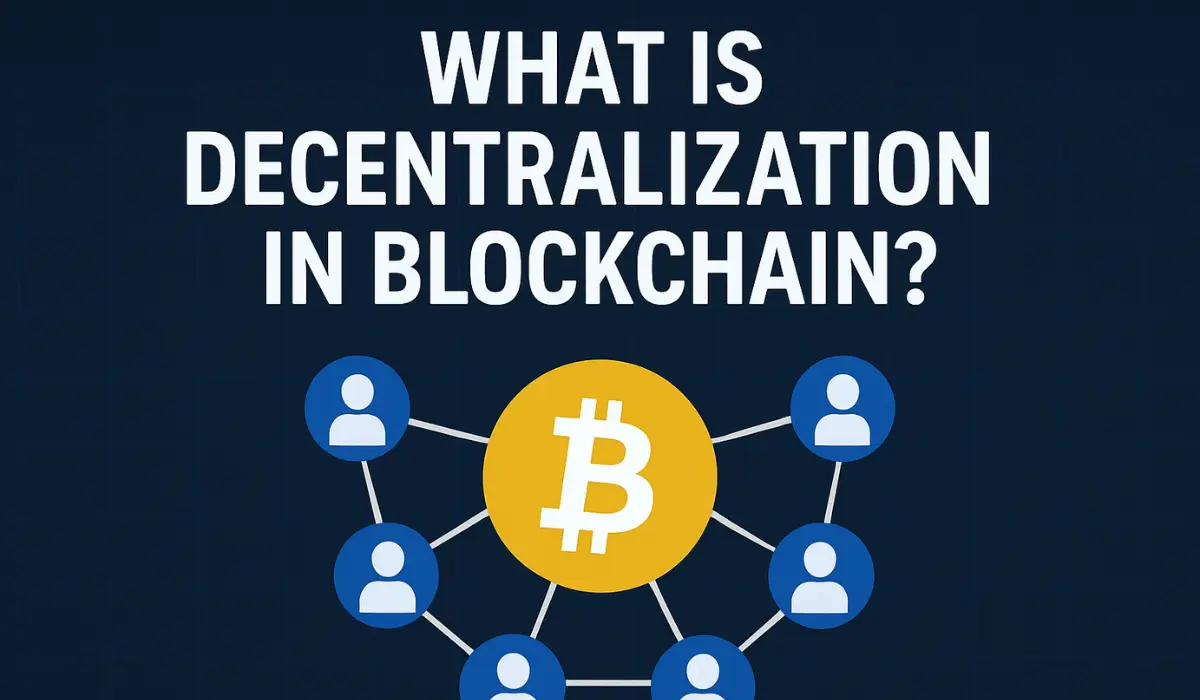What is Decentralization in Blockchain?

The foundation of cryptocurrency and digital assets is blockchain decentralization, which creates specific databases for the decentralization of different currencies that revolve in separate blockchains and have myriad benefits in the digital world. This community-driven consensus prevents single authority control over data and access to all members.
Decentralization is not a new concept, and it is applied to different aspects of the blockchain system that exists on a spectrum. Let’s see how decentralization works, its relevance, benefits, and challenges in the digital world.
Decentralization in Blockchain?
Decentralization refers to the transfer or distribution of authority into multiple networks of participants from a central entity. The participants collectively verify and approve transactions, thereby eliminating reliance on unilateral control by a central authority for decision-making.
It ensures transparency, accountability, autonomy, and greater security to users, thereby reducing the need for intermediaries and providing more control over data.
Blockchains are decentralised to make them better, reliable, and safer, which helps prevent fraudulent activity.
Decentralization makes blockchain safer and stronger with features like burning in blockchain, which reduces supply and increases value by permanently removing tokens.
Importance of Decentralization in Blockchain
Decentralization is resistant to manipulation and lays the foundation for blockchain technology, and grants full ownership of assets and data of individuals.
Token ownership is broad in a decentralized blockchain that reduces the risk of one party’s governance and operations. The process called consensus makes the blockchain more transparent and secure, where each nodes validate and approves. It enhances the maximum productivity with greater efficiency and output since all users have the same authority.
There are no restrictions imposed, and users have the flexibility to change decisions.
How Does Decentralization in Blockchain Work?
To maintain, validate, and secure the system, decentralization in blockchain depends on nodes, which are independent participants of a distributed network.
Each transaction is shared across this network for verification, where its authenticity is verified by nodes. However, decentralization is done only when it is necessary.
Three mechanisms used to achieve decentralization in blockchain are:
- Consensus
- Peer-to-peer network
- Distribution ledger technology
Consensus includes a protocol that enables agreement on the state of the blockchain among network participants without a central authority. This establishes the rules to verify transactions. Protocols included in the consensus are Proof of Work, Proof of State, and Proof of Staked Authority.
Peer-to-peer networks have direct transactions between every network participant, and there’s no intermediary in the process. In the network, each node is equal and participates in ledger maintenance and verification of transactions.
Distributed ledger technology is powered by nodes, which continuously verify and reconcile records. Every participant maintains a copy of the full transaction history.
A blockchain generates multiple copies of data generated by programs called scripts, and it is saved on many machines. For every transaction, a block is added to the blockchain, and it becomes progressively harder to alter; attempting to change a transaction is unfeasible.
Thus, each blockchain contains details of transactions, including sender, recipient, and amount, time of block generation, and a special code called a hash that links to the previous block.
An example of a decentralized organisation is OpenSea
OpenSea is a decentralised Non-Fungible Tokens marketplace that enables peer-to-peer trading of digital art, collectibles, and removes the dependence on a centralized platform. Thereby, it reduces the intermediary fees and improves the marketplace for better buying and selling.
Core Benefits of Decentralization in Blockchain
Decentralization in blockchain technology provides numerous benefits. There’s no identity reveal in the transaction since decentralisation is peer-to-peer, and no central authority is involved, thus reducing the risk of failure.
Some of the key benefits of Decentralization in blockchain include:
- Security enhancement resists data breaches, due to its distributed nature and one-on-one transactions.
- Trustless environmental operation, with each member having a copy of the data in the form of a distribution ledger, and members can determine if any alteration or corruption occurs.
- High transparency and accountability are ensured, as every transaction is documented and accessible to all participants.
- All Data is reconciled in real-time, which ensures no data loss or false data.
- Since there are no intermediaries, blockchain transactions are faster.
Decentralized data is more secure because of data encryption, but it might be costlier than centralization and can be volatile. Also, decentralization faces challenges while governing the network and process of scalability, which leads to slower transaction processing and reduced efficiency. The processing and management of large numbers without centralized authority is a complex task, and users must have deep knowledge of blockchain technology while handling it.
Conclusion
Decentralization grows and expands business, and provides a trustless environment. It reduces points of weakness and reliance on a system, thereby promoting autonomy.
This system in blockchain enhances control access by creating many nodes. Therefore, it is ideal for a system or organization that needs high levels of security, equitable control, and transparency.
However, before investing, understand the mechanism of blockchain technology and decentralization with strong local accountability to avoid chaos. The future of a fair and transparent digital economy depends on it.
FAQs
Increased cost, extreme volatility, and complexity in management are some of the demerits of decentralization
No single entity regulates; instead, there’s a distribution of networks with multiple access and control.
The processing of large numbers of transactions quickly and efficiently during periods of high network activity is known as scalability
It can be known by assessing by dividing the cumulative hash rate and the number of entities. Also, those that have a high node count and a wide distribution which is difficult to control by a single entity.
Yes. Bitcoin is a decentralized digital currency that enables peer-to-peer transactions using blockchain technology.
Crypto & Blockchain Expert
